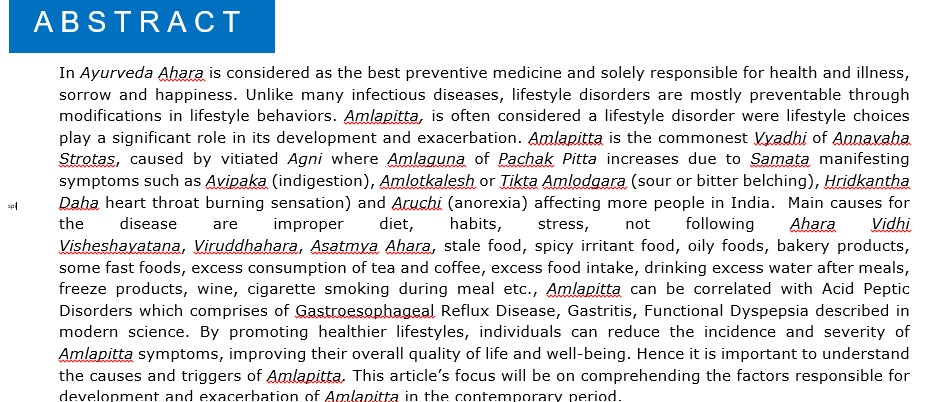A systematic review on causes and triggers contributing to Amlapitta in contemporary era
DOI:
https://doi.org/10.21760/jaims.9.6.19Keywords:
Amlapitta, Agni, Pachak Pitta, Viruddha Ahara, Annavaha Strotas, HyperacidityAbstract
In Ayurveda Ahara is considered as the best preventive medicine and solely responsible for health and illness, sorrow and happiness. Unlike many infectious diseases, lifestyle disorders are mostly preventable through modifications in lifestyle behaviors. Amlapitta, is often considered a lifestyle disorder were lifestyle choices play a significant role in its development and exacerbation. Amlapitta is the commonest Vyadhi of Annavaha Strotas, caused by vitiated Agni where Amlaguna of Pachak Pitta increases due to Samata manifesting symptoms such as Avipaka (indigestion), Amlotkalesh or Tikta Amlodgara (sour or bitter belching), Hridkantha Daha heart throat burning sensation) and Aruchi (anorexia) affecting more people in India. Main causes for the disease are improper diet, habits, stress, not following Ahara Vidhi Visheshayatana, Viruddhahara, Asatmya Ahara, stale food, spicy irritant food, oily foods, bakery products, some fast foods, excess consumption of tea and coffee, excess food intake, drinking excess water after meals, freeze products, wine, cigarette smoking during meal etc., Amlapitta can be correlated with Acid Peptic Disorders which comprises of Gastroesophageal Reflux Disease, Gastritis, Functional Dyspepsia described in modern science. By promoting healthier lifestyles, individuals can reduce the incidence and severity of Amlapitta symptoms, improving their overall quality of life and well-being. Hence it is important to understand the causes and triggers of Amlapitta. This article’s focus will be on comprehending the factors responsible for development and exacerbation of Amlapitta in the contemporary period.
Downloads
References
Sushuruta Samhita, Sutrasthana, Kaviraj Ambicadatt Shastri, Chaukhamba Sanskrit Sansthan Varanasi, Reprint 2017, Vranaprashna Adhyay 21/11, Page 116.
Madhav Nidan, Part 2, Dr. Brahmananda Tripathi, Chaukhmba Surbharti Prakashan, Sanskaran 2005, Amlapitta Nidan Adhyay, 51/3-6 Page 226-227.
Kashyap Samhita, Khilsthana, Ayurvedalankara Shri Satyapal Bhishagaacharya, Choukhamba Sanskrit Sansthan Varanasi, Reprint 2022, Amlapitta Chikitsa Adhyay, 16/10,11, Page 514.
Sarma DN, Barrett ML, Chavez ML, Gardiner P, Ko R, Mahady GB et al. Safety of green extracts: A systematic review by the US pharmacopeia. Drug Saf. 2009; 31:469-484.
HARRISON’S Principles of Internal Medicine, Volume 2, 21st Edition, Mc Graw Hill, part 10 Disorders of Gastrointestinal System, Section 1, Chapter 324 Peptic Ulcer Disease, Page 2437
Ashtang Hridayam, Sutrasthan, Dr. Brahmananda Tripathi, Chaukhamba Sanskrit Prakashan Delhi, Sanskaran 2017, Dravadravyavidnyaniya Adhyay 564, Page 78.
Sushuruta Samhita, Sutrasthana, Kaviraj Ambicadatt Shastri, Chaukhamba Sanskrit Sansthan Varanasi, Reprint 2017, Vranaprashna Adhyay 21/21, Page 118.
Davidson’s Principle and Practice of Medicine Book, 23rd Edition 2018, Sir Stenley Davidson, Part 3, Chapter 21, Gastroenterology, Gasto-oesophageal Reflux Disease Page 791.
Woods HC, Scott H: #Sleepyteens: Social media use in adolescence is associated with poor sleep quality, anxiety, depression and low self-esteem. J Adolesc. 2016, 51:41-9. 10.1016/j.adolescence.2016.05.008.
Davidson’s Principle and Practice of Medicine Book, 23rd Edition 2018, Sir stenley Davidson, Part 3, Chapter 21, Gastroenterology, Gastric and Duodenal Ulcer Page 798.
HARRISON’S principles of internal medicine, Volume 2, 21st edition, Mc Graw hill, part 10 Disorders of Gastrointestinal System, section 1, chapter 323 Diseases of Oesophagus, Page 2431.
Kashyap Samhita, Khilsthana Ayurvedalankara Shri Satyapal Bhishagaacharya, Chaukhamba Sanskrit Sansthan Varanasi, Reprint 2022, Amlapitta chikitsa Adhyay, 16/4 Page 514.
Madhav Nidan, Part 2, Dr. Brahmananda Tripathi, Chaukhmba Surbharti Prakashan, Sanskaran 2005, Amlapitta Nidan Adyay 51/1, Page 225.















